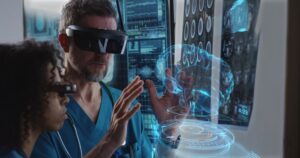In today’s rapidly evolving world, healthcare stands as a prime beneficiary of innovation. Breakthrough technologies are steering the industry towards unprecedented progress, promising improved patient outcomes and revolutionizing medical practices. As we delve into the realm of “Innovation in Motion: Advancing Healthcare through Breakthrough Technologies,” we’ll explore the game-changing role that cutting-edge technologies play in reshaping the healthcare landscape.
1. The Current Landscape of Healthcare Technology
In the face of mounting healthcare challenges, technological solutions have emerged as beacons of hope. Overburdened healthcare systems, shortage of medical professionals, and disparities in access to care have become critical issues worldwide. Breakthrough technologies hold the potential to bridge these gaps by offering innovative approaches to diagnosis, treatment, and patient management. The urgency of addressing these challenges has propelled the healthcare sector into a new era of technological innovation.
2. Role of Breakthrough Technologies in Healthcare
The symbiotic relationship between healthcare and technology is evident in the remarkable strides made possible by breakthrough technologies. These innovations are the driving force behind the ongoing transformation of healthcare. From artificial intelligence (AI) to robotics, telemedicine, and precision medicine, each technology category contributes uniquely to enhancing patient care, streamlining operations, and pushing the boundaries of medical capabilities.
3. Artificial Intelligence and Machine Learning in Healthcare
Artificial intelligence and machine learning have found their footing in healthcare, demonstrating remarkable potential. These technologies analyze vast amounts of medical data to uncover patterns and insights that aid in diagnosing diseases, predicting treatment outcomes, and even personalizing treatment plans. AI-powered image recognition is reshaping radiology, improving the accuracy of diagnoses. Machine learning algorithms are also propelling drug discovery, significantly shortening the research and development process.
4. Robotics Revolutionizing Medical Procedures
The integration of robotics into medical procedures is a testament to technological innovation’s tangible impact. Robotic-assisted surgeries have elevated precision and minimized invasiveness. Surgeons can now operate with enhanced dexterity and precision, leading to faster patient recovery times and fewer complications. This leap in surgical capabilities underscores the synergy between human expertise and robotic precision.
5. Telemedicine and Remote Patient Monitoring
Telemedicine has emerged as a lifeline for healthcare accessibility, particularly in remote or underserved areas. Through virtual consultations and remote patient monitoring, medical professionals can deliver care without the constraints of geographic boundaries. Remote patient monitoring, enabled by wearable devices, empowers individuals to actively manage chronic conditions, while healthcare providers can intervene proactively to prevent emergencies.
6. Precision Medicine and Genomic Technologies
Precision medicine tailors treatment plans to individual patients based on their genetic makeup, offering a personalized approach to healthcare. Genomic technologies unravel the intricacies of an individual’s genetic code, enabling healthcare professionals to predict disease susceptibilities and identify targeted therapies. This groundbreaking approach marks a departure from the one-size-fits-all model, offering more effective and efficient treatments.
7. Ethical and Privacy Considerations
The influx of healthcare data generated by breakthrough technologies raises ethical and privacy concerns. Balancing the potential benefits of data-driven healthcare with patient privacy is a complex challenge. Ensuring data security, obtaining informed consent, and adhering to stringent data protection regulations are vital to fostering trust between patients, healthcare providers, and technology stakeholders.
8. Overcoming Barriers to Implementation
Despite their potential, implementing breakthrough technologies in healthcare encounters resistance due to factors like cost, skepticism, and change management. Addressing these barriers requires collaborative efforts between technology experts and healthcare professionals. Engaging stakeholders, offering comprehensive training, and demonstrating tangible benefits can pave the way for successful technology adoption.
9. Future Outlook: What Lies Ahead
The trajectory of healthcare innovation appears promising, with ongoing research and development poised to yield even more transformative technologies. Integration of augmented reality, 5G connectivity, and nanomedicine could lead to unprecedented advancements. The marriage of breakthrough technologies and healthcare expertise holds the potential to reshape patient care, preventive strategies, and medical research in ways previously deemed unattainable.
Conclusion
The convergence of breakthrough technologies and healthcare is a force to be reckoned with. As we journey through this landscape of innovation, it’s clear that the synergy between technology and healthcare expertise is shaping a future where patient-centric care, precision treatments, and remote accessibility are no longer distant ideals but tangible realities. Through a harmonious collaboration between innovators and healthcare professionals, the path to advancing healthcare through breakthrough technologies is illuminated.




